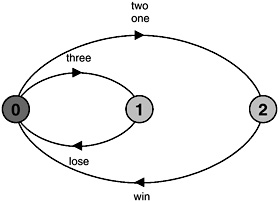Exercises
-
2.1 For each of the following processes, give the Finite State Process (FSP) description of the Labeled Transition System (LTS) graph. The FSP process descriptions may be checked by generating the corresponding state machines using the analysis tool, LTSA.
-
MEETING

-
JOB

-
GAME

-
MOVE

-
DOUBLE

-
FOURTICK

-
PERSON

-
-
2.2 A variable stores values in the range 0..N and supports the actions read and write. Model the variable as a process, VARIABLE, using FSP.
-
For N=2, check that it can perform the actions given by the trace:
write.2→read.2→read.2→write.1→write.0→read.0
-
2.3 A bistable digital circuit receives a sequence of trigger inputs and alternately outputs 0 and 1. Model the process BISTABLE using FSP, and check that it produces the required output; i.e., it should perform the actions given by the trace:
trigger→1→trigger→0→trigger→1→trigger→0 ...
-
(Hint: The alphabet of BISTABLE is {[0],[1],trigger}.)
-
2.4 A sensor measures the water level of a tank. The level (initially 5) is measured in units 0..9. The sensor outputs a low signal if the level is less than 2 and a high signal if the level is greater than 8 otherwise it outputs normal. Model the sensor as an FSP process, SENSOR.
-
(Hint: The alphabet of SENSOR is {level[0..9], high, low, normal}.)
-
2.5 A drinks dispensing machine charges 15p for a can of Sugarola. The machine accepts coins with denominations 5p, 10p and 20p and gives change. Model the machine as an FSP process, DRINKS.
-
2.6 A miniature portable FM radio has three controls. An on/off switch turns the device on and off. Tuning is controlled by two buttons scan and reset which operate as follows. When the radio is turned on or reset is pressed, the radio is tuned to the top frequency of the FM band (108 MHz). When scan is pressed, the radio scans towards the bottom of the band (88 MHz). It stops scanning when it locks on to a station or it reaches the bottom (end). If the radio is currently tuned to a station and scan is pressed then it starts to scan from the frequency of that station towards the bottom. Similarly, when reset is pressed the receiver tunes to the top. Using the alphabet {on, off, scan, reset, lock, end}, model the FM radio as an FSP process, RADIO.
-
For each of the exercises 2.2 to 2.6, draw the state machine diagram that corresponds to your FSP specification and check that it can perform the required actions. The state machines may be drawn manually or generated using the analysis tool, LTSA. LTSA may also be used to animate (run) the specification to produce a trace.
-
2.7 Program the radio of exercise 2.6 in Java, complete with graphic display.
EAN: 2147483647
Pages: 162